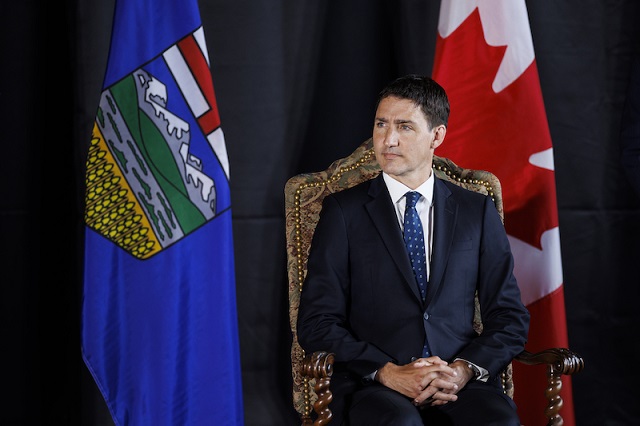Energy
Trudeau gov’t ‘green’ heat pump scheme to cost nearly quadruple initial estimate

From LifeSiteNews
The scheme to try and incentivize Canadians to switch to less reliable heat pumps is expected to cost taxpayers $2.7 billion, up from the original $750 million estimate.
An ideologically charged Canadian federal government “green” program to try and get homeowners to switch their reliable heating oil furnaces for less reliable electric heat pumps via a large grant has been blasted by a taxpayer advocacy group as yet more government waste after it was revealed the program is set to cost nearly four times as much as originally thought.
According to Blacklock’s Reporter, a recent federal Legislative Costing Note from the Parliamentary Budget Office released last Thursday showed that estimated costs for a federal government program to give households $15,000 grants to switch to new heat pumps have gone from $750 million to $2.7 billion.
“The Budget Office estimates there are up to 244,000 households nationwide that could be eligible for program funding,” stated the Legislative Costing Note, which added that if all eligible households access the program, “we estimate the program could have a maximum potential cost of $2.7 billion.”
According to notes from the Enhancements To The Oil To Heat Pump Affordability Program, the program uptake was “projected by extrapolating historical participation trends in the program.”
The original scheme was to allow $10,000 to eligible homeowners to convert from their oil-fired furnaces to an electric heat pump. The cabinet of Prime Minister Justin Trudeau last October expanded the grants to $15,000 along with a $250 “one-time bonus payment.”
As it stands now, the grants apply to residents in the provinces of Nova Scotia, Prince Edward Island and Newfoundland and Labrador.
According to The Budget Office, “approximately 10,000 households” to date have officially qualified for electric heat pump grants.
In October of last year, amid dismal polling numbers that showed his government would be defeated in a landslide by the Conservative Party come the next election, Trudeau announced he was pausing the collection of the carbon tax on home heating oil in Atlantic Canadian provinces for three years.
He then revealed the main reason for the announcement, which was to encourage locals to ditch their home heating oil units for electric heat pumps and said his government would be giving out free pumps to many homeowners.
However, Trudeau refused to offer carbon tax relief to other provinces, such as Alberta and Saskatchewan, for natural gas. This led to Saskatchewan Premier Scott Moe announcing his government would defy the Trudeau government, and stop collecting the federal carbon tax on natural gas in this province, as of Jan 1, 2024.
Taxpayer watchdog: ‘None’ of this is ‘free money’
Franco Terrazzano, Federal Director of the Canadian Taxpayers Federation, told LifeSiteNews that “none” of the money going to the heat pump scheme is “free” and the Trudeau government instead should just scrap the carbon tax.
“Why does it feel like this government can’t keep anything on budget? Is there any wonder why this government is more than $1 trillion in debt?” said Terrazzano.
“None of this is free money.”
Terrazzano noted that if a person is getting a grant from the government, “all of that money will have to be paid back through higher taxes.”
“If the government wanted to make all areas of life more affordable, the government should leave more money in people’s pockets and cut taxes,” he told LifeSiteNews.
“Trudeau should completely scrap his carbon tax.”
Terrazzano added at the “very least,” Trudeau should “extend the same relief he provided to Atlantic Canadians and take the carbon tax off everyone’s home heating bill.”
Heat pumps do not work well in very cold weather unlike a natural gas or oil-fired furnaces, a fact which was even admitted by a former environment minister for the province of British Columbia, Barry Penner.
The Trudeau government is trying to force net-zero regulations on all Canadian provinces, notably on electricity generation, as early as 2035. His government has also refused to extend a carbon tax exemption on heating fuels to all provinces, allowing only Atlantic provinces, this benefit.
Canada has the third largest oil and gas reserves in the world, with most of it in Alberta. However, since taking office in 2015, Trudeau has continued to push his radical environmental agenda similar to the agendas being pushed the WEF’s “Great Reset” and the United Nations’ “Sustainable Development Goals.”
LifeSiteNews has earlier reported on how Trudeau’s carbon tax is costing Canadians hundreds of dollars annually, as government rebates it gives out are not enough to compensate for high fuel costs.
One of the reasons the carbon tax break was applied to Eastern provinces, might have something to do with the fact that there are 24 Liberal MPs up for re-election in Atlantic Canada.
A recent cold snap showed Canadian lives depend on carbon-based fuels to survive winter.
A little over a week ago, an extreme cold snap sent temperatures plummeting to nearly minus 50 degrees Celsius (58 degrees Fahrenheit) in much of Western Canada. It was so cold that the province of Alberta’s power grid almost collapsed due to a failure of wind and solar power. Natural gas and coal are abundant in Canada, notably in Alberta.
In response to the situation, the neighboring province of Saskatchewan, which was also facing the same cold snap, announced it would be providing Alberta with electricity, made from coal and natural gas, to stabilize the grid.
Alberta
Alberta’s grand bargain with Canada includes a new pipeline to Prince Rupert

From Resource Now
Alberta renews call for West Coast oil pipeline amid shifting federal, geopolitical dynamics.
Just six months ago, talk of resurrecting some version of the Northern Gateway pipeline would have been unthinkable. But with the election of Donald Trump in the U.S. and Mark Carney in Canada, it’s now thinkable.
In fact, Alberta Premier Danielle Smith seems to be making Northern Gateway 2.0 a top priority and a condition for Alberta staying within the Canadian confederation and supporting Mark Carney’s vision of making Canada an Energy superpower. Thanks to Donald Trump threatening Canadian sovereignty and its economy, there has been a noticeable zeitgeist shift in Canada. There is growing support for the idea of leveraging Canada’s natural resources and diversifying export markets to make it less vulnerable to an unpredictable southern neighbour.
“I think the world has changed dramatically since Donald Trump got elected in November,” Smith said at a keynote address Wednesday at the Global Energy Show Canada in Calgary. “I think that’s changed the national conversation.” Smith said she has been encouraged by the tack Carney has taken since being elected Prime Minister, and hopes to see real action from Ottawa in the coming months to address what Smith said is serious encumbrances to Alberta’s oil sector, including Bill C-69, an oil and gas emissions cap and a West Coast tanker oil ban. “I’m going to give him some time to work with us and I’m going to be optimistic,” Smith said. Removing the West Coast moratorium on oil tankers would be the first step needed to building a new oil pipeline line from Alberta to Prince Rupert. “We cannot build a pipeline to the west coast if there is a tanker ban,” Smith said. The next step would be getting First Nations on board. “Indigenous peoples have been shut out of the energy economy for generations, and we are now putting them at the heart of it,” Smith said.
Alberta currently produces about 4.3 million barrels of oil per day. Had the Northern Gateway, Keystone XL and Energy East pipelines been built, Alberta could now be producing and exporting an additional 2.5 million barrels of oil per day. The original Northern Gateway Pipeline — killed outright by the Justin Trudeau government — would have terminated in Kitimat. Smith is now talking about a pipeline that would terminate in Prince Rupert. This may obviate some of the concerns that Kitimat posed with oil tankers negotiating Douglas Channel, and their potential impacts on the marine environment.
One of the biggest hurdles to a pipeline to Prince Rupert may be B.C. Premier David Eby. The B.C. NDP government has a history of opposing oil pipelines with tooth and nail. Asked in a fireside chat by Peter Mansbridge how she would get around the B.C. problem, Smith confidently said: “I’ll convince David Eby.”
“I’m sensitive to the issues that were raised before,” she added. One of those concerns was emissions. But the Alberta government and oil industry has struck a grand bargain with Ottawa: pipelines for emissions abatement through carbon capture and storage.
The industry and government propose multi-billion investments in CCUS. The Pathways Alliance project alone represents an investment of $10 to $20 billion. Smith noted that there is no economic value in pumping CO2 underground. It only becomes economically viable if the tradeoff is greater production and export capacity for Alberta oil. “If you couple it with a million-barrel-per-day pipeline, well that allows you $20 billion worth of revenue year after year,” she said. “All of a sudden a $20 billion cost to have to decarbonize, it looks a lot more attractive when you have a new source of revenue.” When asked about the Prince Rupert pipeline proposal, Eby has responded that there is currently no proponent, and that it is therefore a bridge to cross when there is actually a proposal. “I think what I’ve heard Premier Eby say is that there is no project and no proponent,” Smith said. “Well, that’s my job. There will be soon. “We’re working very hard on being able to get industry players to realize this time may be different.” “We’re working on getting a proponent and route.”
At a number of sessions during the conference, Mansbridge has repeatedly asked speakers about the Alberta secession movement, and whether it might scare off investment capital. Alberta has been using the threat of secession as a threat if Ottawa does not address some of the province’s long-standing grievances. Smith said she hopes Carney takes it seriously. “I hope the prime minister doesn’t want to test it,” Smith said during a scrum with reporters. “I take it seriously. I have never seen separatist sentiment be as high as it is now. “I’ve also seen it dissipate when Ottawa addresses the concerns Alberta has.” She added that, if Carney wants a true nation-building project to fast-track, she can’t think of a better one than a new West Coast pipeline. “I can’t imagine that there will be another project on the national list that will generate as much revenue, as much GDP, as many high paying jobs as a bitumen pipeline to the coast.”
Alberta
Alberta Premier Danielle Smith Discusses Moving Energy Forward at the Global Energy Show in Calgary

From Energy Now
At the energy conference in Calgary, Alberta Premier Danielle Smith pressed the case for building infrastructure to move provincial products to international markets, via a transportation and energy corridor to British Columbia.
“The anchor tenant for this corridor must be a 42-inch pipeline, moving one million incremental barrels of oil to those global markets. And we can’t stop there,” she told the audience.
The premier reiterated her support for new pipelines north to Grays Bay in Nunavut, east to Churchill, Man., and potentially a new version of Energy East.
The discussion comes as Prime Minister Mark Carney and his government are assembling a list of major projects of national interest to fast-track for approval.
Carney has also pledged to establish a major project review office that would issue decisions within two years, instead of five.





